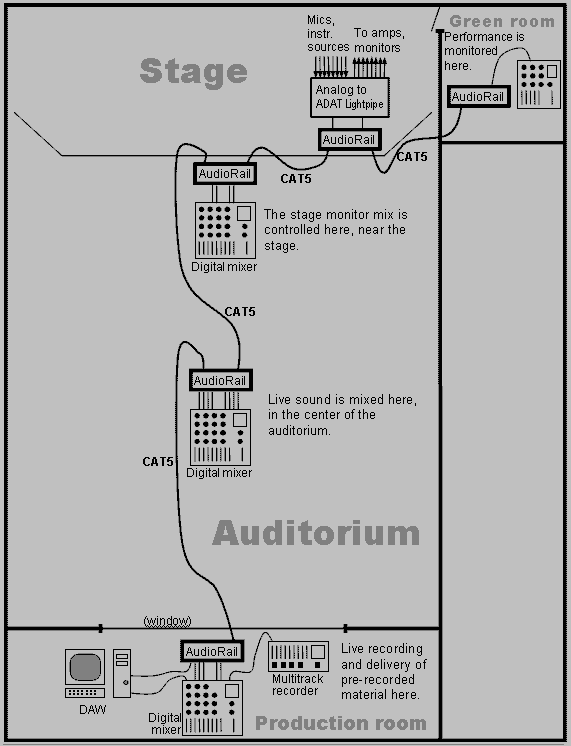AudioRail® Technologies: It simply works.
(Scroll down for more explanation below the picture)

The picture above diagrams an example of AudioRail in a complex live sound configuration.
Five AudioRail nodes are employed, with four CAT5 cables interconnecting them. The functions
at each location in the venue are described below:
Stage
The AudioRail unit on the stage connects to analog/digital conversion units where the live
performance microphones, live instruments, live recording microphones, and outputs to stage
monitors and main speaker amplifiers connect.
Stage monitor mix
The AudioRail unit in front of the stage connects to a digital mixing console (or analog
mixing console with outboard analog/digital conversion). The sound operator here taps off
of all the live microphones and instruments, as well as the pre-recorded material sent live
from the production room and mixes down into each of the stage monitor outputs as appropriate
for the performers.
House mix
The AudioRail unit in the center of the auditorium connects to a digital mixing console
(or analog mixing console with outboard analog/digital conversion). The sound operator
here taps off of all the live microphones and instruments, as well as pre-recorded material
sent live from the production room, and mixes down into the main speakers driving the house
mix.
Production room
The AudioRail unit in the production room connects to a digital mixing console and digital
audio workstation (DAW). The digital mixing console is also connected to a digital multitrack
recorder. The sound operators there take all of the live performance microphones and instruments,
along with additional recording microphones in the auditorium and stage, and do a live multitrack
recording of the performance. Sound operators also deliver the pre-recorded material that is used
in the performance. This room can also be used as a delivery point for live broadcast, and a
mixdown to the Green Room.
Green room
The AudioRail unit in the Green Room connects to a digital mixing console (or analog mixing
console with outboard analog/digital conversion). The Green Room is where the inactive
performers reside while waiting for their turn on stage. A sound operator there takes a
stereo mixdown originating from the production room, and perhaps combines it with a few
other inputs from recording microphones or direct talk-back feeds from the production room,
to generate a Green Room monitor mix.
